Carnival, the operator of more than 100 cruise ships, is taking luxury cruise life to a new level, thanks to a tiny little wearable called the Ocean Medallion.
First unveiled by Carnival CEO Arnold Donald at the CES 2017 tech trade show, the Ocean Medallion has been in the works for more than four years, and now the company is rolling it out. It enables the cruise ship operator to stay engaged with its guests anywhere they are inside a 17-deck “love boat.” I visited one of Carnival’s ships, the Royal Princess, recently when it was docked in San Francisco and got a VIP tour of the ship. It was a magical experience that foretells the way that the internet of things ought to work, once we all have access to it.
The Royal Princess is one of three Carnival cruise ships that have been outfitted with more than 7,000 sensors, 4,000 interactive digital portals, and a couple of datacenters. Those devices are connected with thousands of guest smartphones and Medallion wearables. And they are synchronized through multi-constellation satellites to the cloud. Cruise ships previously were self-contained as far as computing went, but now they are backed up on the cloud. John Padgett, chief experience and innovation officer at Carnival, said a ship can now be run from data in the cloud if necessary.
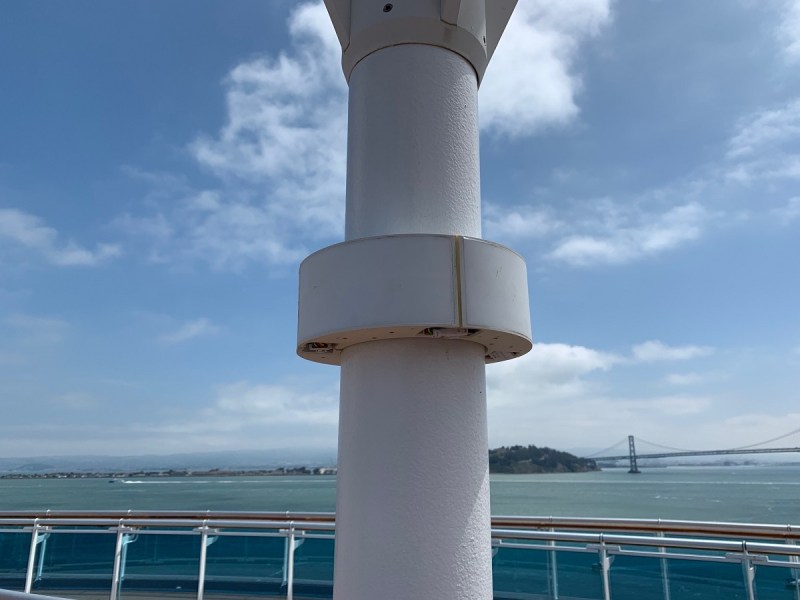
Above: Sensors are hidden in spots like this one on the Royal Princess.
So long as you opt in (and more than 99.5% of the guests do), you can go anywhere among the 37,000 tons of steel on the ship and it will know where you are. In fact, you can order a drink on your smartphone and a crew member will find you anywhere on the ship and bring it to you. I watched them do this at a bar on the ship. And, while wearing your Medallion wearable, which is the size of a quarter and weighs 1.8 ounces, you can walk up to your cabin door and it will recognize you and unlock it.
June 5th: The AI Audit in NYC
Join us next week in NYC to engage with top executive leaders, delving into strategies for auditing AI models to ensure fairness, optimal performance, and ethical compliance across diverse organizations. Secure your attendance for this exclusive invite-only event.
“MedallionClass is intended to be the most personalized, the most simple vacation experience that exists on the planet at scale,” said Padgett, in a press briefing aboard the Royal Princess cruise ship while it was in port in San Francisco. “We’re taking the world’s largest cruise ships, with thousands of guests and crew members, and making sure the experience feels unique to you. Innovation is taking the entire experience back to the roots of what makes cruising special. This ship carries the most-connected internet of things implementation for humans on the planet.”
Big ambitions
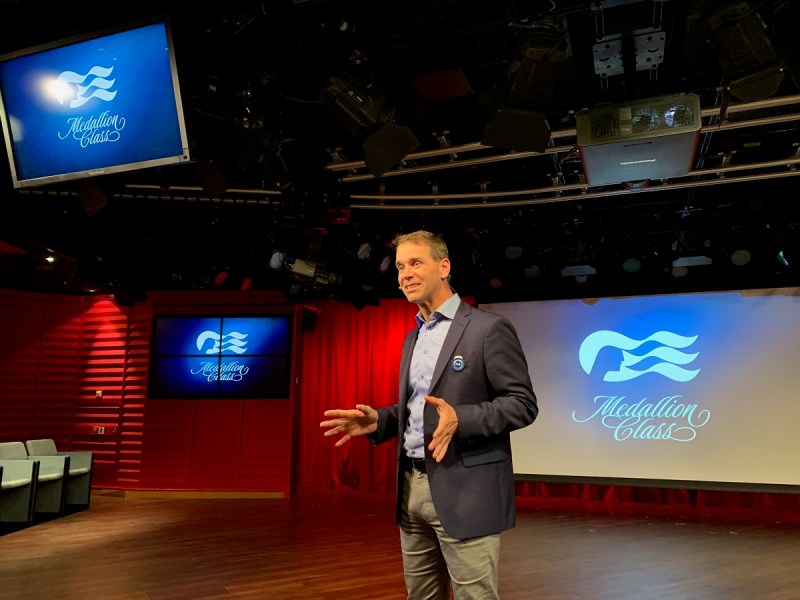
Above: John Padgett of Carnival has been working on Ocean Medallion tech for more than four years.
That’s a big statement. But there aren’t many places where it makes so much sense to be tracked. If you’ve got an elderly person on the ship, you don’t want to have to worry about that person getting lost. You don’t want to search through 17 decks to find grandma. Or if you’ve got kids aboard, you want to make sure they haven’t accidentally fallen off the ship.
So far, three cruise ships have the Medallions: the Caribbean Princess, Regal Princess, and Royal Princess. Two more will have it by the end of the year. By the end of 2020, guests sailing in the Caribbean, Alaska, Panama Canal, Europe, Australia/New Zealand, Mexico, California Coast, and on the World Cruise will have the ability to use the Ocean Medallion. Eventually, all of Carnival’s 117 cruise ships will have it. That’s no small task, since those cruise ships carry more than two million passengers a year.
To create this experience, Carnival worked with outside vendors such as The Experience Engine (TE2), a San Diego, California-based company that creates experience platforms-as-a-service. The sensors provide data to the xIOS, or the Experience Innovation Operating System.
So far, the Medallions have been a big hit on the three ships, based on high guest satisfaction scores, said Padgett. Everybody on board the ship can get a Medallion at no extra cost. Inside each guest’s Ocean Medallion are multiple communication technologies, including near field communication (NFC) and Bluetooth Low Energy (BLE).
The data on the device itself is akin to an encrypted license plate. With a special protocol that synchronizes with the 7,000 sensors, the ship can zero in on your location so a crew member can find you within a relatively short distance of where you actually are. The device has your name and sail date on it so you can be checked while embarking or disembarking at ports.
“From a privacy and security standpoint, your information is not printed on things laying around the ship anymore,” Padgett said. “It is secure, abstracted, and encrypted.”
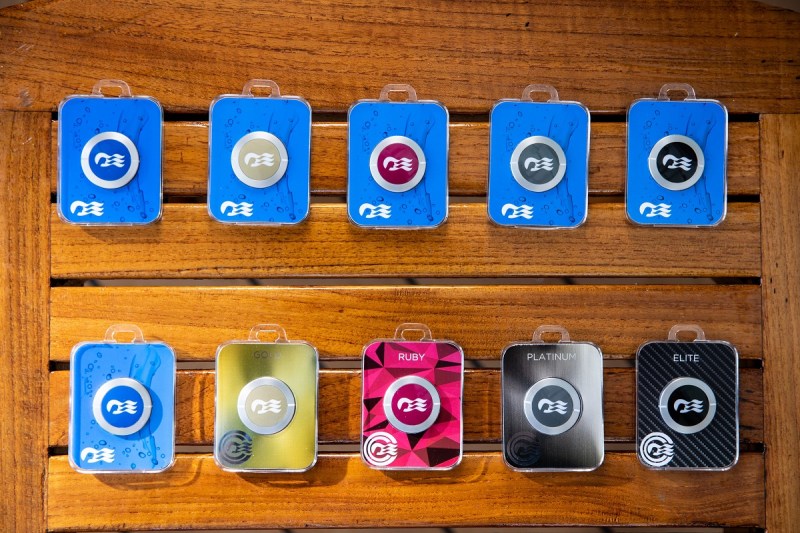
Above: Carnival’s Ocean Medallion wearables weigh 1.8 ounces.
Carnival went with the wearable because not every guest has a phone, particularly older guests.
“Anyone in travel can segment a group of guests, call it special, and say this is a next-level experience,” Padgett said. “It’s a completely different thing to take an existing ship and raise the experience for every single person on board at no additional cost. And that is what we’re doing with Ocean Medallion. Every element of the entire guest experience is based on Medallion.”
Not only do the Medallions make the guest experience better, they also make life easier for the crew, who no longer have to engage in a big guessing game about what the guests want at any given time.
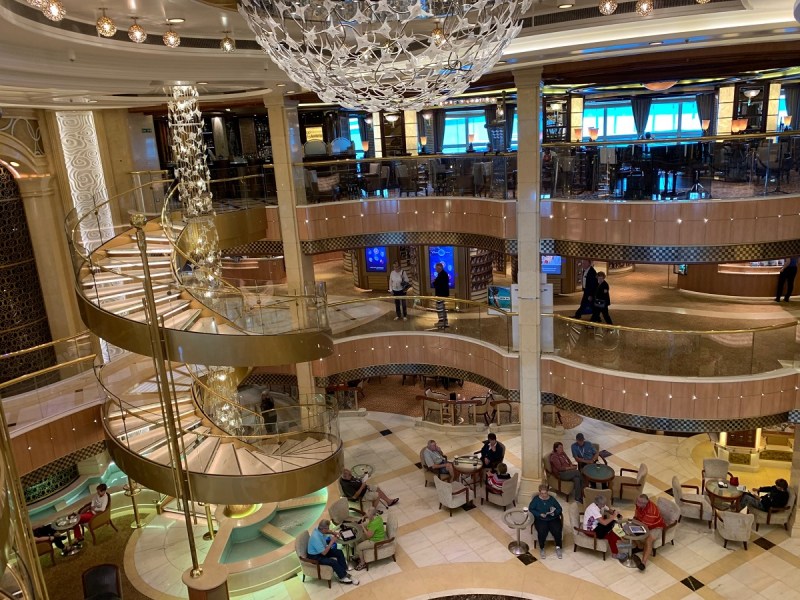
Above: There are 7,000 sensors on the Royal Princess.
It starts when you arrive at the terminal for the ship. You can check in with your passport and take a picture. That gets added to your digital profile. You are given a Medallion associated with the profile, and crew members can verify that it’s you because of the photo. That enables two-factor authentication. So now you can get onto the boat much faster and start your pre-cruise entertainment almost immediately upon boarding. From your transportation to the lido deck, it will take maybe 10 minutes. And you won’t have to produce your identification every time you do a transaction since the Medallion tells the crew who you are.
“Typically, if you go to a Vegas resort or destination or theme park, you have one interaction and another interaction,” Padgett said. “We unified all of those interactions in a single platform. You engage with us ubiquitously.”
Ocean Portals
“It’s completely frictionless,” Padgett said.
You can order a bunch of stuff from your smartphone app. The on-demand services apply to restaurant food, beverages, retail stores, and hospitality services delivered to your location. You no longer have to pay for it with cash or even wait while they verify your room number. You don’t have to wait for a check in a restaurant or bar. You just leave when you want to do so.
What happens if you lose your Medallion? You can go to certain stations where they can look up your photo and issue you a new one. And sometimes they can just tell you where your lost Medallion is.
If you’re traveling in a group, you can use the family and friend locator. You can have your family members opt in to being connected to your party, and then you can find them using a smartphone app or an OceanPortal. The portals are big digital screens in front of the elevators or lobbies on most of the decks. You can tap the big screens with your Medallion and it will recognize you. If you tap on the image of someone in your party, it will tell you the location of that person. If you don’t know exactly how to get to that person, you can ask for point-to-point waypoints to get to the person. You can also use the portal to chat with the other party.
“You can have instant location awareness with the friend finding,” Padgett said. “We’re talking about four city blocks or more. If you walk the wrong way, you are 15 minutes out of your way. Then you turn back. Those are minutes of your experience time that you never get back.”
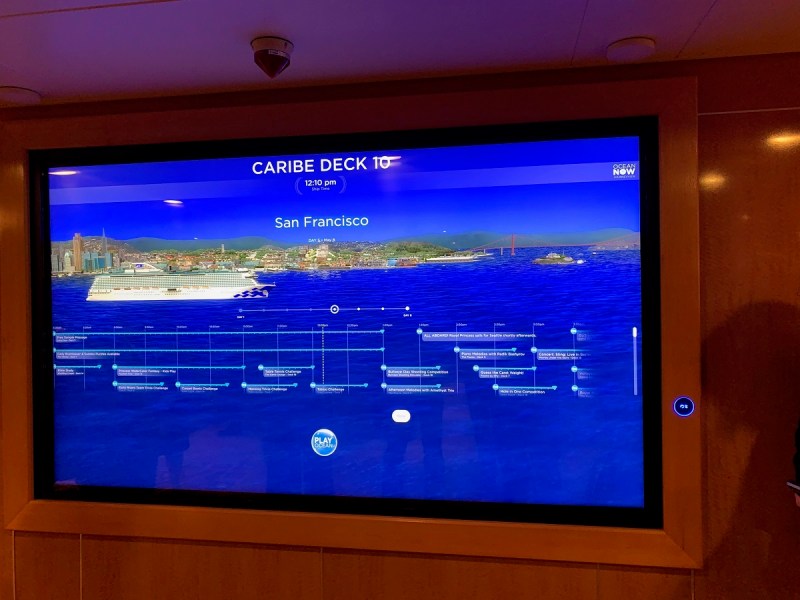
Above: You can see your personal calendar on OceanPortal screens on the ship.
The portals are good for another purpose. Before you start your trip, you can get an app and plan your trip ahead of time, based on the scheduled activities like a dinner special or a comedy show. When you arrive, you can look at your schedule on your phone or go to a portal display. When you log in, you can see your timeline for what you are supposed to be doing at any given time on the JourneyView. That helps you stay organized when you’re supposed to be doing things like getting a massage on deck 10. You can also add events to your itinerary.
Ocean Medallion’s various benefits
When I walked with a group to a stateroom, I could see that every room had a small tablet near the door. It had the name of the guests (you can hide your identity if you wish) on the tablet. When you are within 10 feet or so, the door automatically unlocks. If you walk away, then it locks. You can see personalized greetings, like an anniversary wish, on the tablet. No longer do you have a set of keys to lose. This door is one of the biggest factors in positive ratings for the new experience, Padgett said.
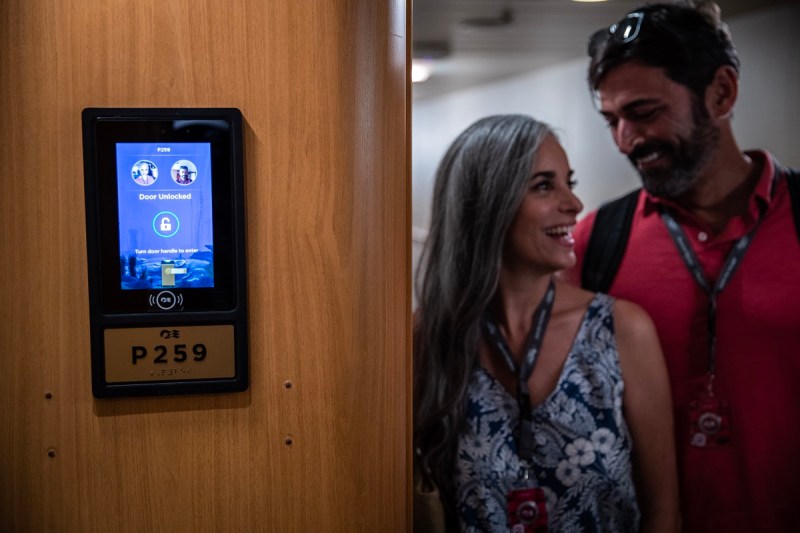
Above: Your wearable unlocks the door on the Carnival Royal Princess cruise ship.
Inside your cabins, you can turn on the TV and see what the weather looks like topside at the pool. The housekeepers, who have their own tablets or smartphones with special crew apps, can appreciate the wearables because they indicate whether a guest is in a cabin. If the guest is not there, then the housekeepers can clean the room without worrying about waking up somebody with a knock on the door. Guests are no longer asked to stay out of their cabins at certain times of the day. Housekeepers can use an app to keep track of which rooms have already been serviced and which ones still need to be cleaned.
The system works better for all crew members, as they can focus on more meaningful interactions with guests, rather than spending time hunting them down or getting information that they should already have.
And the captain can have peace of mind by knowing where just about everybody on the ship is located at any given time. In the event of an emergency, the crew can locate any of the 4,300 guests.
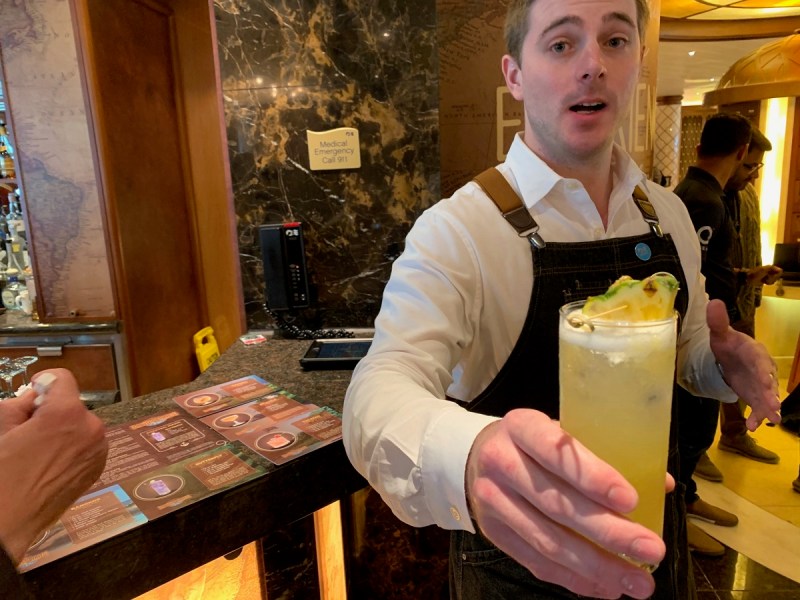
Above: A crew member brings me a lemonade ordered on demand via Carnival’s app.
“If you think of how the cruise ships evolved, it’s masses of people going to things like the theater or dining or disembarking,” Padgett said. “The Medallion flips this upside down and Uberizes the service, so things are delivered to your location on demand. Instead of you going to find it, we now bring it to you.”
You can also go to the casino and play the various casino games on physical machines and tables. Or you can place bets via your smartphone from anywhere on board the ship. You can make bets on slots, poker, bingo, roulette, keno, and lotteries.
And if you are not a gambler, you can play games. On portals shipwide or smart devices, you can engage with the PlayOcean suite of games. These feature things like a shipwide digital scavenger hunt, customizable avatars, and more. You can even play with the PlayOcean Everywhere app after the cruise is over. When you are on land, you can’t play the PlayOcean Casino games for real money. But when you are away at sea, the ship allows you to play real-money gambling games.
Carnival has teamed up with Jeff Corwin, a celebrity adventurer, to create a weekend TV show dubbed Ocean Trek with Jeff Corwin. And Corwin and his cohost pose challenges to you during the scavenger hunt as you make your way around the big ship.
Up on the pool deck, I watched a bunch of guests playing a trivia game on a giant screen. The guests could answer questions on their phones and compete with other guests at the pool. Or, if you like, you can also compete with guests on other cruise ships.
Fast internet
If you want to share your experience, it’s pretty easy because you can get more than 20 megabits a second downstream (76 megabits a second upstream) wireless internet via the MedallionNet, which connects via both low-earth orbit and mid-earth orbit satellites. We were able to get that kind of speed in the middle of the ship.
Those satellites have 0.2-second latency. The ship uses multiple constellations of satellites because some of them are affected by bad weather. The system has redundancy to ensure connectivity, Padgett said.
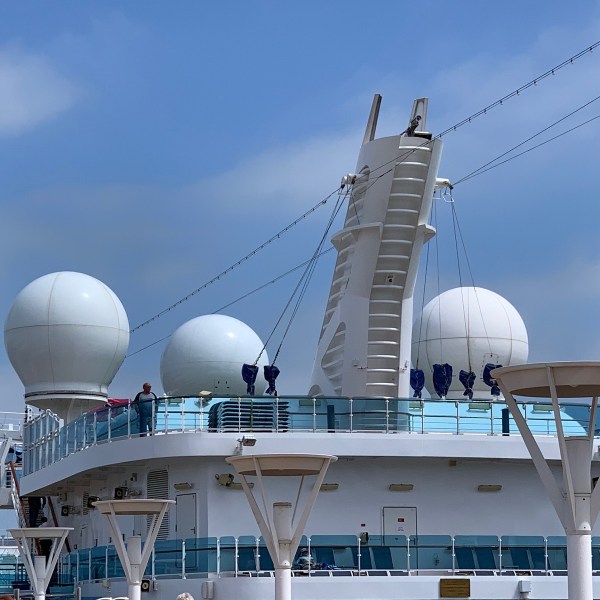
Above: The big balls are connections for satellites that deliver internet access on a cruise ship.
Every state room has a Wi-Fi access point. The connectivity is pervasive and unlimited throughout the ship. It costs $10 a day. And the public Wi-Fi network is not connected to the same network as the ship’s vital systems.
For me, that’s a mind blower. I went on a cruise years ago and I remember have to pay $15 a minute to use the one computer on the ship with a slow satellite connection.
“The apex of the technology is the human interaction,” Padgett said. “This is the first intelligent guest operation.”
Carnival is retrofitting as many ships as it can at the moment. But it takes time, as cruise ships are out of service only 12 to 14 days every three years. But this kind of investment can make even an older ship seem brand new, and retrofitting a ship with new technology is a lot cheaper than making a brand new ship. Carnival has six new ships coming in 2020, but it could retrofit the whole fleet in the coming years.
Conclusion

Above: Carnival’s PlayOcean games are accessible via portal screens on ships.
If this works out, it could expand the market for cruises.
“We want every cruise ship in the world to be full,” Padgett said. “We are about 1% of the hotel rooms in the world. It’s really about making cruising more of a mainstream, contemporary, relevant consumer product that is a vacation alternative more people choose.”
And once you are done with the cruise, you can stay engaged with the apps so that the memory of the cruise will stay with you longer.
I haven’t been on a cruise lately, but I’m anxious to try this out. The last one I was on made me feel like it was the 19th century.
It’s great to see the cruise industry come into the modern age. In some ways, we’ll have to say hello to screens on ships and say goodbye to being unplugged while on the high seas. But it’s a big benefit to be able to find the people you want on a ship, get the services you want more quickly, and maximize the time that you are paying for. It’s also going to be a safer experience, and that means it will be more relaxing as well.


